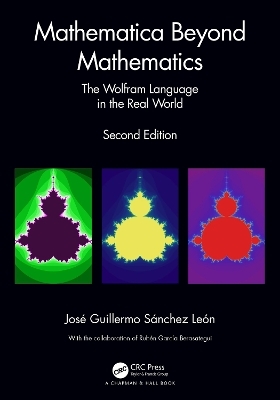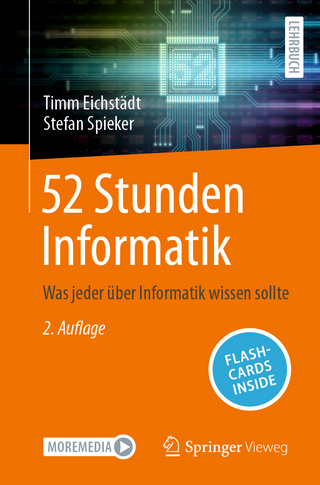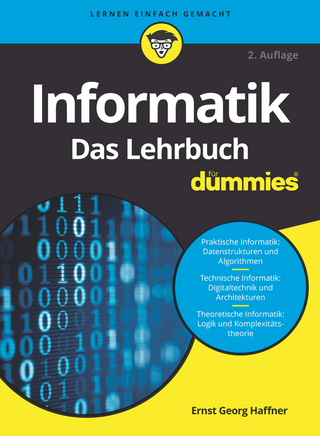
Mathematica Beyond Mathematics
Chapman & Hall/CRC (Verlag)
978-1-032-00483-9 (ISBN)
Although many books have been written about Mathematica, very few of them cover the new functionality added to the most recent versions of the program. This thoroughly revised second edition of Mathematica Beyond Mathematics: The Wolfram Language in the Real World introduces the new features using real-world examples based on the experience of the author as a consultant and Wolfram certified instructor. The examples strike a balance between relevance and difficulty in terms of Mathematica syntax, allowing readers to incrementally build up their Mathematica skills as they go through the chapters While reading this book, you will also learn more about the Wolfram Language and how to use it to solve a wide variety of problems.
The author raises questions from a wide range of topics and answers them by taking full advantage of Mathematica's latest features. For example: What sources of energy does the world really use? Are our cities getting warmer? Is the novel El Quixote written in Pi? Is it possible to reliably date the Earth using radioactive isotopes? How can we find planets outside our solar system? How can we model epidemics, earthquakes and other natural phenomena? What is the best way to compare organisms genetically?
This new edition introduces the new capabilities added to the latest version of Mathematica (version 13), and discusses new topics related to machine learning, big data, finance economics, and physics.
New to the Second Edition
Separate sections containing carefully selected additional resources that can be accessed from either Mathematica or online
Online Supplementary materials including code snippets used in the book and additional examples.
Updated commands to take full advantage of Mathematica 13.
José Guillermo Sánchez León (http://diarium.usal.es/guillermo) is an engineer, physicist and mathematics PhD holder. He is currently a mathematics and statistical consultant and teaches Mathematical modeling at the University of Salamanca. He has worked in the energy industry and conducted research in a variety of fields: Modeling, optimization, medical physics, astronomy, finance and others. In 1999, he was awarded a research grant at Wolfram Research Inc. headquarters in Champaign (Illinois, USA) after his statistical applications with Mathematica project won a competition sponsored by the company. Since then, he has been an active Mathematica and webMathematica alpha and beta tester. He is also a Wolfram certified instructor and has extensive experience in teaching and developing programs with both applications. Among his more than 100 articles, there are several where Mathematica and webMathematica have been used extensively.
1. Getting Started. 1.1. Mathematica, an Integrated Technical Computing System. 1.2. First Steps. 1.3. Editing Notebooks. 1.4. Basic Ideas. 1.5. From Graphics to Machine Learnings. 1.6. Additional Resources and Supplementary Materials. 2. Programming: The Beauty and Power of the Wolfram Language. 2.1. Mathematica’s Programming Language: The Wolfram Language. 2.2. Lists Operations. 2.3. Association and Dataset. 2.4. Matrix Operations. 2.5. Set, Set Delayed and Dynamic Variables. 2.6. Functional vs. Procedural Programming. 2.7. Apply, Map, and Other Related Functions. 2.8. Iterative Functions. 2.9. Pure Functions. 2.10. Global and Local Variables. 2.11. Conditional Expressions and Conditions. 2.12. Accuracy and Precision. 2.13. Choosing the Method of Computation. 2.14. Optimizing the Computation Time. 2.15. Cloud Deployment. 2.16. Package Development. 2.17. Additional Resources. 3. Interactive Applications, Image Processing, and More. 3.1. The Manipulate Function. 3.2. Creating Demonstrations. 3.3. Image Processing. 3.4. Image Manipulation. 3.5. Graphs and Networks. 3.6. Application: Finding the Period of a Pendulum. 3.7. Additional Resources. 4. Accessing Scientific and Technical Information. 4.1. The Wolfram Data Framework: Introducing Entities. 4.2. Computable Data Functions. 4.3. The Wolfram Data Repository. 4.4. Weather Data in Real Time. 4.5. Chemical and Physical Properties of Elements and Compounds. 4.6. Life Sciences and Medicine. 4.7. Earth Sciences and Geographic Data. 4.8. Additional Resources. 5. Data Analysis and Manipulation. 5.1. Importing/Exporting. 5.2. Statistical Analysis. 5.3. Probability Distributions. 5.4. Exploratory Data Analysis. 5.5. Bootstrapping and Confidence Estimates. 5.6. Curve Fitting. 5.7. Time Series Analysis. 5.8. Spatial Statistics. 6.9. Additional Resources. 6. Machine Learning and Neural Networks. 6.1. What is Machine Learning. 6.2. Classification. 6.3. Prediction. 6.4. Working with Neural Networks. 6.5. Additional Resources. 7. Calculating π and Other Mathematical Tales. 7.1. The Origins of π. 7.2. Archimedes’ Approximation. 7.3. π with More Than One Billion Decimals. 7.4. Buffon’s Method. 7.5. Application: Are the Decimal Digits of π Random? 7.6. The Strange Connection. 7.7. The Riemann Hypothesis. 7.8. Looking for the Magic Prime Formula. 7.9. Additional Resources. 8. Looking at the Sky. 8.1. A Short Astronomical Walk. 8.2. Solar Analemma. 8.3. Stargazing. 8.4. Application: Determining the Color of the Stars. 8.5. The Measurement of Distances Across the Universe. 8.6. Application: Binary Systems and the Search for Exoplanets. 8.7. Light Curves. 8.8. Additional Resources. 9. Nuclei and Radiations. 9.1. Nuclear and Particle Physics. 9.2. What are Isotopes? 9.3. Decay Constants, Decay Periods and Half-Lives. 9.4. Decay Chains. 9.5. Application: Modeling the Evolution of a Chain of Isotopes Over Time. 9.6. Application: Dating the History of Humankind. 9.7. Application: Calculating Binding Energies. 9.8. Radiation Attenuation. 9.9. Additional Resources. 10. Modeling: Applications in Biokinetics, Epidemiology and More. 10.1. Compartmental Modeling. 10.2. Epidemiological Models. 10.3. Physiological Modeling. 10.4. Fitting a Model. 10.5. Optimal Experimental Designs (OED). 10.6. BIOKMOD: The New Iodine OIR Model (ICRP 137). 10.7. Additional Modeling Examples. 10.8. Modeling Using PDEs. 10.9. Additional Resources. 11. Economic, Financial and Optimization Applications. 11.1. Accessing Economic Information. 11.2. Financial Information. 11.3. Financial Functions. 11.4. Optimization. 11.5. The Shortest Path Problem. 11.6. Optimum Flows. 11.7. Blockchains. 11.8. Additional Resources. 12. Faster, Further. 12.1. Parallel Computing. 12.2. Parallel Programming. 12.3. The Mandelbrot Set. 12.4. Comparing Organisms Genetically. 12.5. Compute Unified Device Architecture (CUDA). 12.6. Software Development with Wolfram Workbench. 12.7. Connecting with Other Programs and Devices. 12.8. Additional Resources.
| Erscheinungsdatum | 06.12.2022 |
|---|---|
| Zusatzinfo | 349 Line drawings, color; 4 Halftones, color; 353 Illustrations, color |
| Sprache | englisch |
| Maße | 178 x 254 mm |
| Gewicht | 1380 g |
| Themenwelt | Mathematik / Informatik ► Informatik ► Theorie / Studium |
| Technik ► Umwelttechnik / Biotechnologie | |
| ISBN-10 | 1-032-00483-5 / 1032004835 |
| ISBN-13 | 978-1-032-00483-9 / 9781032004839 |
| Zustand | Neuware |
| Informationen gemäß Produktsicherheitsverordnung (GPSR) | |
| Haben Sie eine Frage zum Produkt? |
aus dem Bereich


